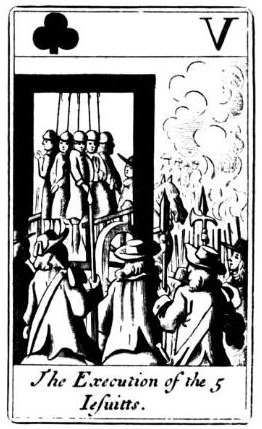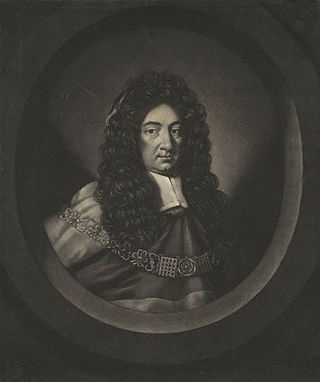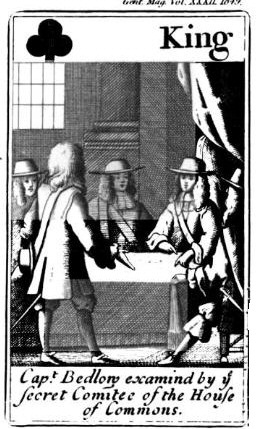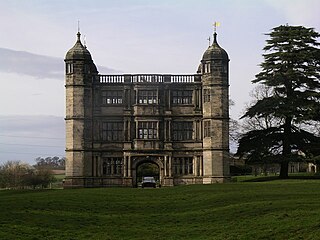
Titus Oates was an English priest who fabricated the "Popish Plot", a supposed Catholic conspiracy to kill King Charles II.

The Popish Plot was a fictitious conspiracy invented by Titus Oates that between 1678 and 1681 gripped the kingdoms of England and Scotland in anti-Catholic hysteria. Oates alleged that there was an extensive Catholic conspiracy to assassinate Charles II, accusations that led to the executions of at least 22 men and precipitated the Exclusion Bill Crisis. During this tumultuous period, Oates weaved an intricate web of accusations, fueling public fears and paranoia. However, as time went on, the lack of substantial evidence and inconsistencies in Oates's testimony began to unravel the plot. Eventually, Oates himself was arrested and convicted for perjury, exposing the fabricated nature of the conspiracy.

Sir William Scroggs was Lord Chief Justice of England from 1678 to 1681. He is best remembered for presiding over the Popish Plot trials, where he was accused of showing bias against the accused.

William Bedloe was an English fraudster and Popish Plot informer.
Walter Aston, 2nd Lord Aston of Forfar was the second and eldest surviving son of Walter Aston, 1st Lord Aston of Forfar, and Gertrude Sadleir, daughter of Sir Thomas Sadleir of Standon, Hertfordshire, and his second wife Gertrude Markham. Lady Aston was the granddaughter of the noted Elizabethan statesman Sir Ralph Sadler.
Walter Aston, 3rd Lord Aston of Forfar was the eldest son of Walter Aston, 2nd Lord Aston of Forfar, and his wife Lady Mary Weston, daughter of Richard Weston, 1st Earl of Portland. He is best remembered today as a fortunate survivor of the Popish Plot.

Tixall is a small village and civil parish in the Stafford district, in the English county of Staffordshire lying on the western side of the Trent valley between Rugeley and Stone, Staffordshire and roughly 4 miles east of Stafford. The population of the civil parish taken at the 2011 census was 239.

William Ireland was an English Jesuit and martyr from Lincolnshire. He was falsely accused of conspiring to murder King Charles II during the Popish Plot hysteria, and was executed on 24 January 1679. He was beatified in 1929 by Pope Pius XI and his feast day is celebrated on 24 January, the day of his death.

William Howard, 1st Viscount Stafford, FRS was the youngest son of Thomas Howard, 21st Earl of Arundel, and his wife, the former Alethea Talbot. A Fellow of the Royal Society from 1665, he was a Royalist supporter before being falsely implicated by Titus Oates in the later discredited "Popish Plot", and executed for treason. He was beatified as a Catholic martyr by Pope Pius XI in 1929.

David Lewis, S.J. was a Jesuit Catholic priest and martyr who was also known as Charles Baker. Lewis was canonized by Pope Paul VI in 1970 as one of the Forty Martyrs of England and Wales and is venerated as a saint in the Catholic Church. His feast day is celebrated on 27 August.
William Petre, 4th Baron Petre was an English peer and victim of the Popish Plot.

Tixall Gatehouse is a 16th-century gatehouse situated at Tixall, near Stafford, Staffordshire and is all that remains of Tixall Hall which was demolished in 1927. The gatehouse is a Grade I listed building. Tixall was used as a prison for Mary, Queen of Scots for two weeks in 1586.

Thomas Whitbread was an English Jesuit missionary and martyr, wrongly convicted of conspiracy to murder Charles II of England and hanged during the Popish Plot. He was beatified in 1929 by Pope Pius XI and his feast day is celebrated on 20 June.
Richard Gerard of Hilderstone, Staffordshire was a victim of the Popish Plot of the reign of Charles II of England. He was a Roman Catholic recusant landowner in Staffordshire, and came forward as a witness in the defence of the accused Catholic aristocrat, William Howard, 1st Viscount Stafford, which led to his own death in prison, although he had never been brought to trial.

William Barrow was an English Jesuit, executed as a result of the fictitious so-called Popish Plot, that between 1678 and 1681 gripped the Kingdoms of England and Scotland in anti-Catholic hysteria. Barrow is regarded as a martyr of the Roman Catholic church and was beatified in 1929.

Stephen College was baptised as Stephen Golledge in Hertfordshire (1637–1681) was an English joiner, activist Protestant, and supporter of the perjury underlying the fabricated Popish Plot. He was tried and executed for high treason, on somewhat dubious evidence, in 1681.
Edward Turberville or Turbervile was a Welsh professional soldier and priest hunter, better known to history as an informer who perjured himself in support of the fictitious Popish Plot.

John Fenwick, real surname Caldwell was an English Jesuit, executed at the time of the fabricated Popish Plot. He is a Catholic martyr, beatified in 1929 by Pope Pius XI.
Andrew Bromwich was an English Roman Catholic priest. He was a survivor of the Popish Plot, and the founder of the Oscott Mission in Staffordshire, which later became St. Mary's College, Oscott.

John Gavan was an English Jesuit. He was a victim of the fabricated Popish Plot, and was wrongfully executed for conspiracy to murder King Charles II. He was beatified in 1929 by Pope Pius XI.















